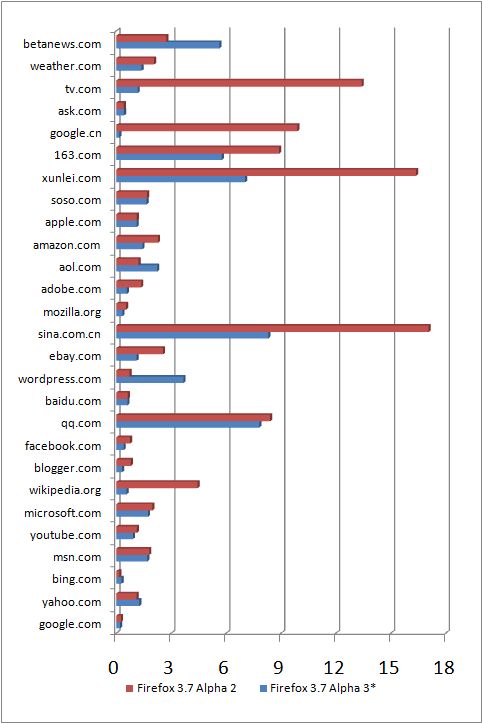The road back to par: Radical reconstructive surgery planned for Firefox 4.0
The road from here to there
To help Firefox make the quantum leap from its current state to a level competitive with the others, version 3.7 will serve as a kind of waypoint. Already, we're seeing some other performance features being tried in the new Alpha 2 and the latest daily development builds of Alpha 3.

The latest builds now feature Mozilla's first round of minimalistic tweaks to the skin, which include getting rid of one button in the controls. Since there's no reason why the Refresh and Stop buttons would be used together, they're now the same button, with the icon changing as necessary (Stop as the page is loading, Refresh once it's finished).
Last November, Firefox 3.7 alpha code was commandeered for an unofficial test of rendering using Direct2D, the Windows graphics library that replaces the decades-old GDI. Internet Explorer 9 is slated to use Direct2D, and the early IE9 tests we saw last year (the only ones revealed thus far) showed tremendous gains in the graphics department. But the Mozilla engineer's test was somewhat inconclusive, resulting in a build that actually appeared to slow down page load time when rendering with Direct2D instead of GDI.

Comparative Web page load times for Firefox 3.7 Alpha 2 rendering with GDI graphics library, and Firefox 3.7 Alpha 3 rendering with Direct2D graphics library.
Now with Direct2D support having been officially welded into the latest Firefox 3.7 alphas for the first time, the results are a little more like what folks expected: In a test (originally suggested to us by Microsoft) of page load times for 26 leading Web sites, a daily Alpha 3 build with Direct2D rendering turned on did load pages, on average, 5% faster than the latest general Alpha 2 with Direct2D turned off. But as the graph shows, test results per page could vary wildly, and more often than not, Alpha 3 was much faster than that.
From what I can see with my own two eyes, Direct2D rendering on Firefox 3.7 (and the early IE9, for that matter) is crisper, cleaner, and snappier than with GDI. As this feature becomes more prevalent in browsers everywhere, in turn, it will become relevant to more users. So at some time in the near future, it will become necessary to include graphics library rendering time as an element of Betanews' "comprehensive" browser tests, if we truly wish to go on using that word to describe them.
It's usually Microsoft that keeps telling us that true browser performance is something its user can see and feel. Coming from the manufacturer of the perennial slowest browser in the field, that must be a heartfelt statement. In the next few weeks, Microsoft will be making its case for browser performance -- something it hasn't been able to lay claim to for some time. Until that company gives folks reason to go back to being disappointed, IE9 will be perceived as gaining on Firefox.
Which means, Mozilla cannot afford any more to evolve on its own schedule; in this competitive environment (which is what it said it wanted), the schedule is set for it. Firefox 3.7 needs to put all these improvements together and demonstrate it can continue to revolutionize browser architecture, even if it doesn't quite catch up with Safari or the others just yet. But then, it needs to knock Firefox 4.0 into the stratosphere, because in a market that's becoming more knowledgeable about its environment by the day, consumers don't place bets on the also-ran for very long.
